Ohio is Split in Two! (sort of…)
The two parts that comprise the geology of Ohio are the eastern and western halves of the state. The west side of Ohio is rich in limestone while the eastern side is rich in sandstone underlain by shale. Limestone is not very resistant to the humidity in the state, and its erosion over millions of years has led to a mostly flat landscape. Sandstone is much more resistant in comparison to both limestone and shale, so the areas that have not been flattened are those where the shale is protected by sandstone. This is why large valleys are common in eastern Ohio.
The original sequence of sedimentary rock strata (from bottom to top) was limestone, shale, and sandstone. These layers were tilted, forming an arch before erosion had occurred. The crest of this arch occurred in western Ohio in a north-south orientation and the low-lying toe of the arch occurred in eastern Ohio. Much of the erosion was caused by a pre-glacial river, the Teays River, which flowed for around 200 million years. The erosion caused by the river and its streams was stopped by the advancing glaciers of the Ice Age, which happened less than a million years ago.
The Ice Age glaciers were slowed by the sandstone hills in eastern Ohio. This led to a glacial boundary which extends no less south than Canton, Ohio.
Till is an unsorted mixture of sand, clay, silt, and boulders. In western Ohio, the till is high in lime and clay content, and lime and clay content is low in eastern Ohio.
The basic substrate for plants in western Ohio is lime and clay till, which is relatively impermeable, high in lime, poorly drained, and poorly aerated. The basic substrate for plants in eastern Ohio is low nutrient and highly acidic. The sandstone causes the substrate to be more permeable in some areas, while the shale causes it to be less permeable. In areas where sandstone is mantled by till, the soil is more rich in nutrients.
Five species of trees/shrubs whose distributions are limited to limestone or limey substrates includes redbud, fragrant sumac, hackberry, blue ash, and chinquapin oak.
Five species of trees/shrubs whose distributions are limited to high-lime, clay-rich substrates developed in the thick glacial till of western Ohio include sugar maple, beech, red oak, shagbark hickory, and white oak.
Five species of trees/shrubs whose distributions are limited to sandstone hill of eastern Ohio includes chestnut oak, sourwood, scrub pine, pitch pine, and hemlock.
The major determinant of the distribution of sweet buckeye is that it does not occur inside the glacial boundary which might be caused by issues related to repopulation or climate. Hemlock grows in un-glaciated eastern Ohio as well, but it extends past the northern glacial boundary. This is likely due to it needing cool, moist environments which can be found in the bottoms of valleys. Rhododendron lives south of the glacial boundary and belongs to the mixed mesophytic forest.
Calciphiles
Fragrant Sumac (Rhus aromatica)

Fragrant Sumac
Fragrant sumac thrives in lime-rich soil, like that found in western Ohio. It is native to most of the US east of the Rocky Mountains, from Ontario and western Quebec, Massachusetts and New Hampshire to Florida and west to the Great Plains in Texas to South Dakota. It grows at a range of sites including open rocky woodlands, valley bottoms, lower rocky slopes, and roadsides. https://plants.usda.gov/DocumentLibrary/plantguide/pdf/cs_rhar4.pdf
American Hackberry (Celtis occidentalis)
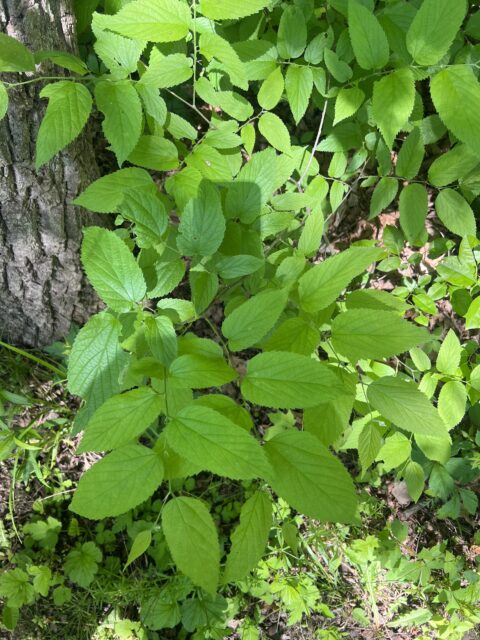
American Hackberry
American hackberry thrives in lime-rich soil. It produces edible fruits that are high in protein, carbohydrates, and fat and were often eaten by Native Americans. https://www.nps.gov/places/vama-hackberry.htm
Chinquapin Oak (Quercus muehlenbergii)
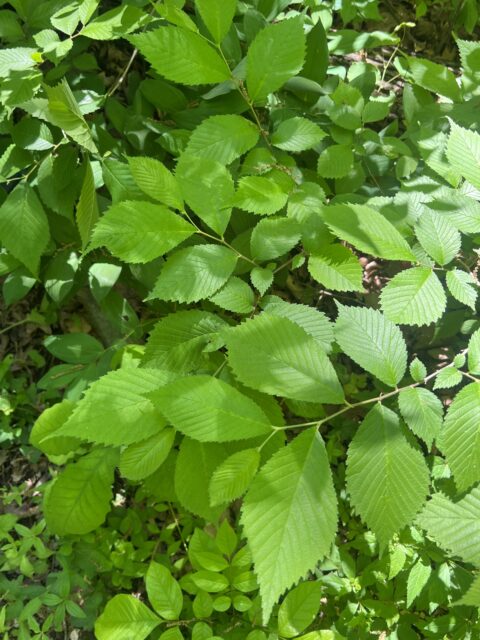
Chinquapin Oak
Chinquapin oak thrives in lime-rich soil (hint: all the calciphiles do). Pioneers used this oak to make thousands of miles of fencing throughout Ohio, Kentucky, and Indiana. https://www.arborday.org/trees/treeguide/TreeDetail.cfm?ItemID=875#:~:text=The%20chinkapin%20oak%20is%20also,from%20Pittsburgh%20to%20New%20Orleans.
American Columbo (Frasera caroliniensis)

American Columbo
American Columbo is the last calciphile (lime-loving) plant that I documented on this trip! American columbo flowers only one time before it dies, and in the image you can see that it has not flowered yet. https://www.ontario.ca/page/american-columbo#:~:text=American%20Columbo%20may%20live%20for,antidiarrheal%2C%20antiemetic%20and%20a%20disinfectant.
Invasive Species
Japanese Honeysuckle (Lonicera japonica)
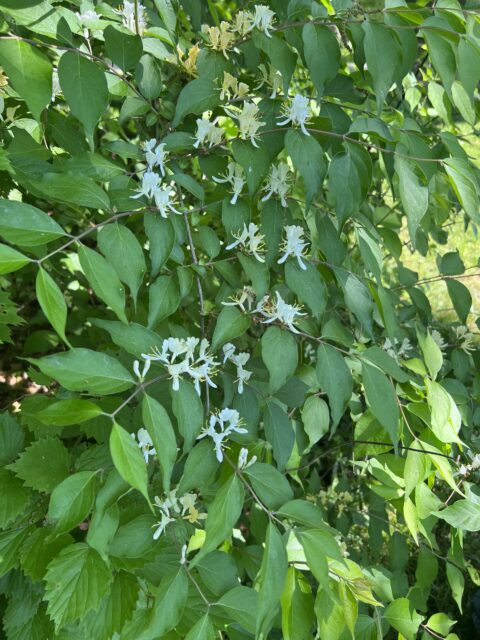
Japanese Honeysuckle
Japanese honeysuckle is invasive throughout the eastern United States and west towards Texas. It was originally brought to New York in 1806 for ornamental, wildlife, and erosion control purposes. It is able to live in varying habitats ranging from full sun to full shade. It is fast-growing and wraps around the stems of shrubs and herbaceous plants. When it grows in full sun, it forms tangles that can smother and kill other vegetation. https://www.invasive.org/alien/pubs/midatlantic/loja.htm#:~:text=Japanese%20honeysuckle%20is%20one%20of,scattered%20occurrences%20in%20the%20Southwest.
Garlic Mustard (Alliaria petiolata)
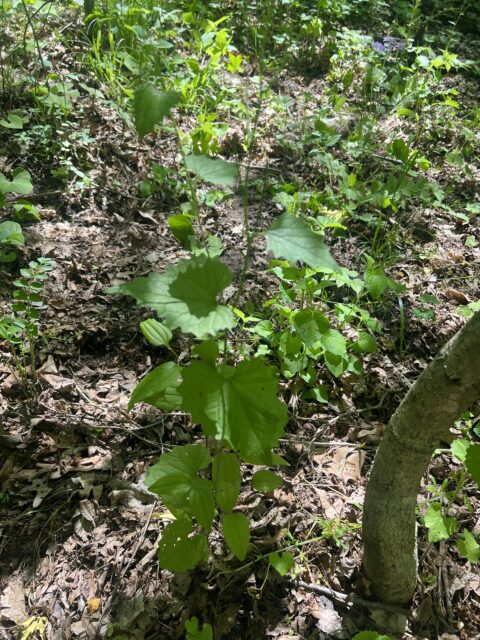
Garlic mustard
Garlic mustard is highly invasive and was originally brought over from Europe in the 1800’s for herbal uses and erosion control. Garlic mustard is edible, but becomes more toxic with age which requires extensive cooking for it to be edible. Garlic mustard spreads its seeds via wind, and emerges earlier in the spring than other native plants. When native plants begin to emerge, garlic mustard has occupied a lot of their available space, stealing sunlight, moisture, and nutrients. https://www.nature.org/en-us/about-us/where-we-work/united-states/indiana/stories-in-indiana/garlic-mustard/
Green Ash vs Blue Ash
My assignment for this trip was to compare two different types of ash trees, and the ones I documented were green ash and blue ash!
Green Ash (Fraxinus pennsylvanica) & Blue Ash (Fraxinus quadrangulata)
Both of these ash trees have a pinnately compound structure, which is characteristic of ash trees. The leaves of the blue ash are always toothed, while the leaves of the green ash are sometimes toothed, sometimes not! I prominent characteristic of the blue ash that separates it from green ash is that their twigs are square.

Green Ash
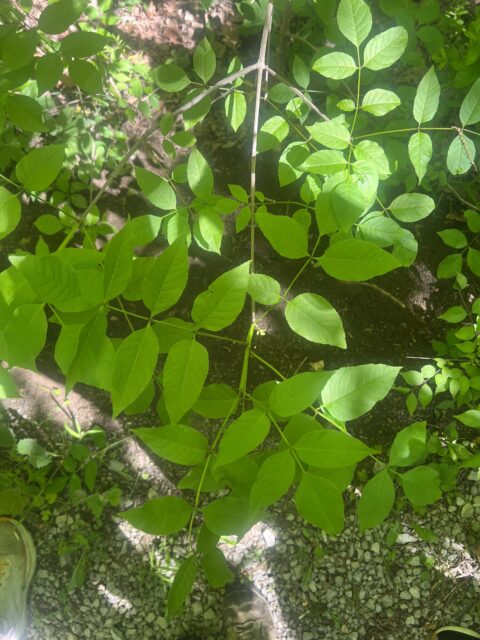
Blue ash
